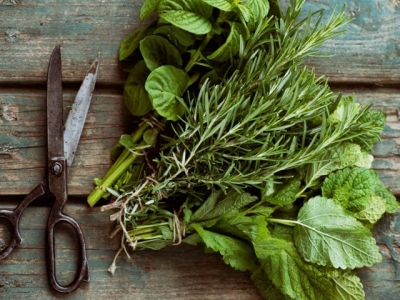How to Harvest and Dry Herbs

Shutterstock
For discerning cooks, packaged herbs from the grocery store don’t always cut it. Judging from their flavor and aroma, it seems they were picked by greasy, diesel-powered machine harvesters in some third-world country about 10 years ago. (This might be a slight exaggeration. Just slight.)
But this is exactly why you grow fresh herbs outside your kitchen door. The quality is incomparable. Preserving that quality for the upcoming dormant season is easy find just a half-hour one morning before the first frost to stock your herb rack for the winter.
When to Pick
The flavor and aroma of herbs comes from the essential oils contained in the leaves, which varies depending on the time of day and the stage of the plant’s life cycle. The best-quality dried herbs are picked when the essential oil content is at its peak, which is when the plant is producing only leaves, not flowers or seeds.
You’ve probably harvested your herbs repeatedly throughout the summer, in which case you’ve noticed that they send out new shoots each time they’re cut. If left uncut long enough, they start to flower and set seed, so try to time the harvest for when there is plenty of lush green growth but when flowers haven’t yet formed. It’s best to do this in early fall; as the days get shorter, most herbs enter the flowering stage more quickly in an effort to set seed before the end of growing season.
The heat of the sun causes essential oils to vaporize and fill with air with their aroma. For this reason, it’s best to harvest herbs in the morning while the leaves are still saturated with flavor. Not too early, however, because they won’t dry as easily when they’re covered with dew. Aim for the brief window when the sun has just hit them and the dew has dissipated.
How to Pick
Use scissors to clip off the stems, cutting only the fresh new top growth, not the older leaves lower down. To avoid depleting the plant, harvest no more than one-third of the growth at any given time. Most culinary herbs are perennials, but with annual herbs (like basil, cilantro, and dill), it’s fine to harvest all of the fresh healthy leaf material in the fall since the plants will die with the first frost.
How to Dry
The classic way to dry herbs is to hang them from the ceiling of your kitchen. This fills the house with wonderful fragrances, creating a warm and soothing harvest ambiance for the harvest season. Simply bundle five to 10 herb stalks with a piece of twine, and hang them up upside down. You may want to run twine from the one side of the ceiling to the other and tie each bundle to it. You can put the herb bundles in any room that’s warm and dry. Sunlight degrades herb quality, so bundle the herbs inside paper bags if they will receive direct sun exposure while drying. Poke holes in the paper bags to aid with air circulation.
Best quality herbs are those that dry slowly. However, there is a fine line between drying slowly and becoming moldy. Herbs with high water content (such as basil, chives, cilantro, parsley, and mint) may dry too slowly if they are bundled and hung, rotting before they are fully dry. As an alternative, spread them out flat on a window screen that is suspended off the ground so that air can circulate beneath it. Put this in a dry, shady place with good air circulation. Leaving a fan on low in the room will speed the process and help prevent mold.
If your herbs are getting moldy because the humidity level in your home is too high or if you’re in hurry you can dry herbs quickly in a food dehydrator, or even in the oven. If using an oven, spread the herbs out on cookie sheets and set it to the lowest possible temperature. The flavor is degraded if the temperature goes above 100 degrees, so you may have to keep the door of the oven open to create the right environment.
How to Store
Herbs are ready to store as soon as they become crisp and crumbly to the touch. It’s best not to over dry them, so check regularly to see when they are ready for storage. Bundled herbs take several weeks to dry, while herbs laid out on drying screens may be ready in a week or less. The oven method produces dry herbs in as little as two or three hours.
Always store dried herbs in glass containers in a cool, dark place. If pantry space is an issue, remove the leaves from the stalks and crumble them before storing. However, the ideal method preferred by the most discriminating cooks is to leave them on the stalk and crumble them the moment they’re added to a meal.
Related news
 7 Perennial Herbs to Plant Now
7 Perennial Herbs to Plant Now Growing vegetables successfully takes ample dedication and a fair bit of growing space plus the knowledge to do it right
 Grow Lights for Indoor Plants and Indoor Gardening: An Overview
Grow Lights for Indoor Plants and Indoor Gardening: An Overview Indoor growing offers many advantages. The biggest benefits are the most obvious: garden pests can’t get at your plants, and you have total control over
 How to Build a Three-Bin Composter
How to Build a Three-Bin Composter A three-bin system that allows you to have different piles in various stages of doneness: You start the pile on one end, move it to the second bin